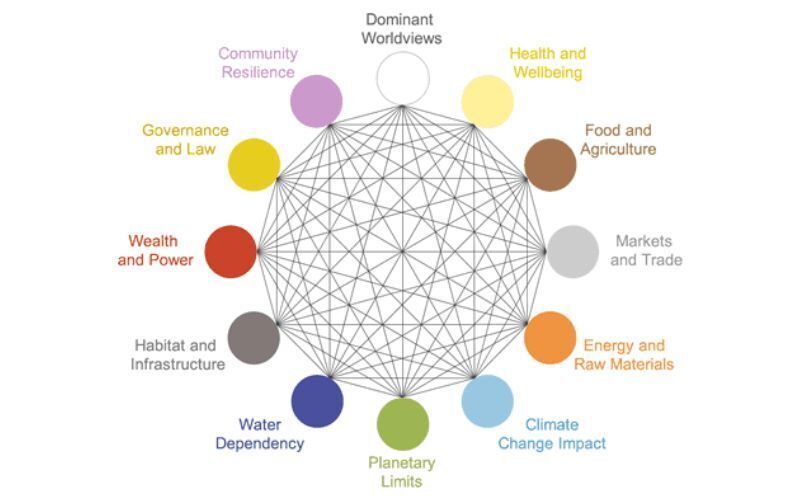If your community or team is interested in offering a simulation please contact us. It is best played with 20-30 participants.
IFF Member Tony Hodgson has developed a World System Model (see below) as a tried, tested, and fine-tuned representation of the complexity of the global problematique. It offers the most straightforward way to examine and understand the interconnected problems we face and formulate creative and transformative ways of approaching those problems. It can be used in many different ways – for developing strategic resilience, interpreting horizon scanning, and as an educational tool for one-planet living.

The IFF World Game makes the model immediately accessible to any group (school governors, city councilors, health service managers, concerned citizens, boards of directors, UN High Commission, and so on).
There is more material in these pages about the structure of the model, the scanning database that supports it, etc. But the entire explanation is in Tony Hodgson’s book Ready for Anything: Designing Resilience in a Transforming World.
Played in Collaboration with the International Futures Forum (IFF)
- What kind of trouble is our species and our planet in? What’s likely to happen next?
- How can we think creatively about and understand the interconnected problems (climate, health, energy, governance, economy, etc.) we face without getting overwhelmed by their complexity and uncertainty?
- How can we get ready for whatever is coming next? What can we do practically in business and the community at local, national, and international levels?
- What sort of help does resilience offer? How can we design resilience? What happens when we do?
Whether you help run a country, a corporation, an NGO, a public service, a city, a school, or a family… these are complicated questions.
In the face of such multiple challenges, we can quickly feel overwhelmed, lapse into cynicism, denial, or despair, or limit our attention to the business requirements. Yet the real question is, can we - individuals, families, communities, organizations, and nations - find the skill, courage, and integrity to respond creatively to these powerful times and support others? Can we harness the power of our human ingenuity to rise to the challenge and create a “good life” that is sustainable within the resources of our single planet?
The Model
The World System Model is a clear and memorable way of looking at the challenge of the global problematique in a way that keeps it together in our minds, helps us talk to others about it, and helps focus us on what matters in generating positive ideas for the future in any local situation.
The circular diagram (below) is the main icon for the World System Model. It explores the twelve key issues and positions them as the nodes of sustainable living. In recent research, each node is described – and some of the main trends are summarized.
It is essentially a mental model for representing what we need to pay attention to in our minds. Focusing on the critical factors in planetary viability and their dynamic interconnections in a living system creates a robust framework for learning that allows groups to engage with the greater complexity of our global predicament. We can then seek solutions that are less likely to overlook critical connections and less likely to generate the unintended consequences of so many of our current initiatives.
People who work with the model or play the World Game gain confidence in stepping out of their silos of expertise, seeking new information in areas of ignorance, and placing their challenges in the broader context for a successful response.
The model is the brainchild of IFF Member Tony Hodgson and is the subject of his book, Ready for Anything – Designing resilience for a Transforming World. Tony continues to lead the development of the world modeling project.
The Twelve Factors
Resilience cannot be achieved through attending to only one aspect of living. It requires multiple elements, but it also requires recognizing and understanding how these factors connect and interact. As we consider more factors, their interconnections increase rapidly. For example, four elements have six connections, but nine have thirty-six connections.
We need to balance too much complexity and be too simple. Twelve nodes have been chosen to cover the main aspects of community resilience. We can use the familiar visual image of the clock face to help us hold twelve factors in mind simultaneously.
The twelve factors in the World System Model have been chosen as essential to understanding what is needed to develop viable and sustainable societies at every level, from the local to the global. The standard catch-all terms of economy, technology, politics, environment, and culture have deliberately been avoided. The test for inclusion is that removing any one of the factors destroys the viability of the whole system.
With twelve factors, any one of which might affect or be affected by another, there are sixty-six possible interconnections. The connections can be mutually supportive in the human ecological system; they can be absent and weaken the system; or negative associations, throwing the system into imbalance and non-sustainability.


